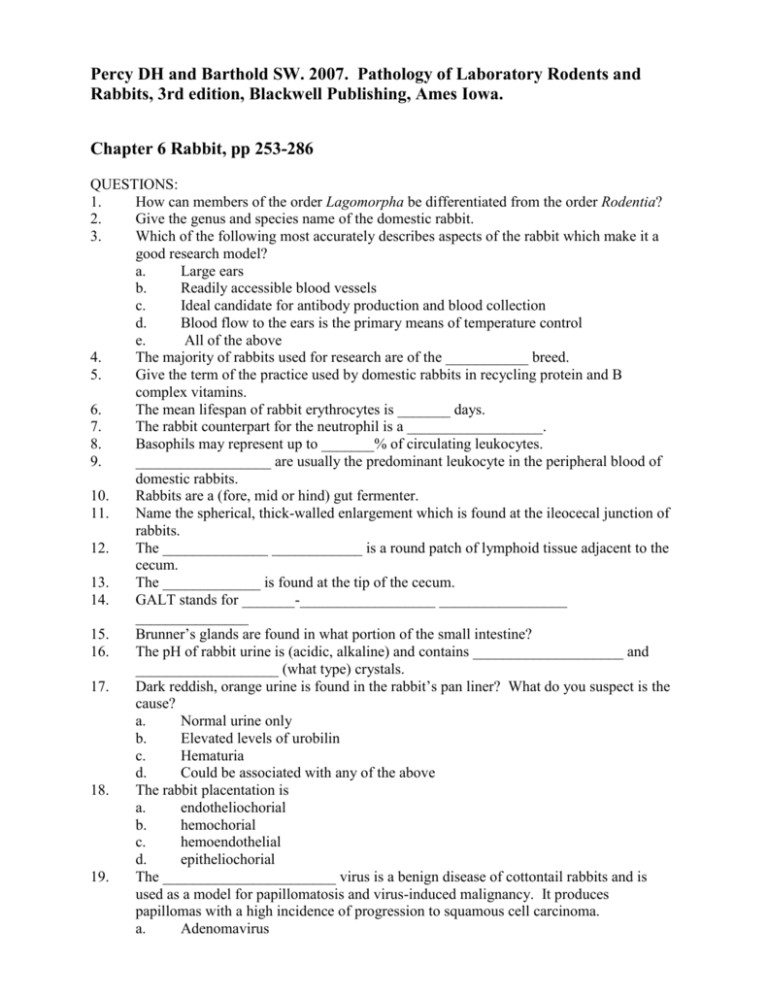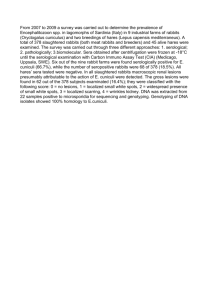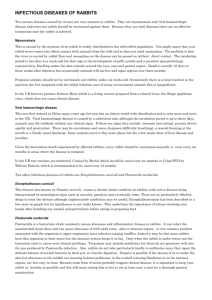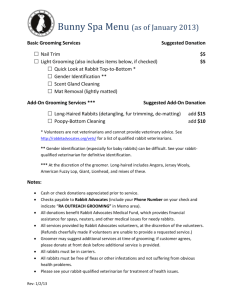Chapter 6: Rabbit - Laboratory Animal Boards Study Group
advertisement

Percy DH and Barthold SW. 2007. Pathology of Laboratory Rodents and Rabbits, 3rd edition, Blackwell Publishing, Ames Iowa. Chapter 6 Rabbit, pp 253-286 QUESTIONS: 1. How can members of the order Lagomorpha be differentiated from the order Rodentia? 2. Give the genus and species name of the domestic rabbit. 3. Which of the following most accurately describes aspects of the rabbit which make it a good research model? a. Large ears b. Readily accessible blood vessels c. Ideal candidate for antibody production and blood collection d. Blood flow to the ears is the primary means of temperature control e. All of the above 4. The majority of rabbits used for research are of the ___________ breed. 5. Give the term of the practice used by domestic rabbits in recycling protein and B complex vitamins. 6. The mean lifespan of rabbit erythrocytes is _______ days. 7. The rabbit counterpart for the neutrophil is a __________________. 8. Basophils may represent up to _______% of circulating leukocytes. 9. __________________ are usually the predominant leukocyte in the peripheral blood of domestic rabbits. 10. Rabbits are a (fore, mid or hind) gut fermenter. 11. Name the spherical, thick-walled enlargement which is found at the ileocecal junction of rabbits. 12. The ______________ ____________ is a round patch of lymphoid tissue adjacent to the cecum. 13. The _____________ is found at the tip of the cecum. 14. GALT stands for _______-__________________ _________________ _______________ 15. Brunner’s glands are found in what portion of the small intestine? 16. The pH of rabbit urine is (acidic, alkaline) and contains ____________________ and ___________________ (what type) crystals. 17. Dark reddish, orange urine is found in the rabbit’s pan liner? What do you suspect is the cause? a. Normal urine only b. Elevated levels of urobilin c. Hematuria d. Could be associated with any of the above 18. The rabbit placentation is a. endotheliochorial b. hemochorial c. hemoendothelial d. epitheliochorial 19. The _______________________ virus is a benign disease of cottontail rabbits and is used as a model for papillomatosis and virus-induced malignancy. It produces papillomas with a high incidence of progression to squamous cell carcinoma. a. Adenomavirus 20. 21. 22. 23. 24. 25. 26. 27. 28. 29. 30. 31. 32. b. Adenovirus c. Polyomavirus d. Papillomavirus The natural host of rabbit (Shope) papillomatosis is: a. Oryctolagus b. Sylvilagus The most common oral location for pedunculated oral papillomatosis lesions in domestic rabbits is: a. dorsal tongue b. maxillary gingiva c. mandibular gingiva d. ventral tongue Which of the following virus types has been isolated from primary rabbit kidney cultures? a. Pox virus b. Adenovirus c. Parvovirus d. Polyoma virus Give the genus and species name of the “brush rabbit”. What infectious agent of rabbits has been used as a means of biological control for a specific population of rabbits? Vectors for transmission of myxomatosis include _____________ and ______________. Shope fibroma virus was first isolated from a cottontail rabbit (provide genus and species name) in the US in 1932.. The primary site for viral replication of rabbit pox in the naturally occurring disease is the ____________________________. True or False???? Herpes sylvilagus replicates well in kidney cells prepared from the domestic rabbit, however viral infection of the NZW rabbit has not been successful. Rabbit hemorrhagic disease (RHD) is caused by a: a. calicivirus b. picornavirus c. herpesvirus d. poxvirus Which of the following diseases have been used as a form of biological control for wild rabbit populations? a. Rabbit pox b. Myxomatosis c. Rabbit hemorrhagic disease d. Leporid Herpesvirus 1 infection e. both a and b f. both b and c g. all of the above Coronavirus infection may be associated with which of the following clinical syndromes: a. enteritis b. pleural effusion c. cardiomyopathy d. all of the above Rotaviral infection is usually confined to what animal age groups? 33. 34. 35. 36. 37. 38. 39. 40. 41. 42. 43. 44. Snuffles, atrophic rhinitis, suppurative otitis media, and genital tract infection are characteristic clinical signs of infection with _________________. True or False: Localized suppurative bronchopneumonia is naturally produced in rabbits inoculated intranasally with Bordetella bronchiseptica. CAR Bacillus infection can be demonstrated best by which of the following techniques? a. silver stain b. H & E stains c. electron microscopy d. both a & b e. both a & c List 4 of the eight agents now recognized to play a role in the “enteritis complex” of rabbits. The most common clostridial pathogen associated with the enteritis complex in juvenile rabbits is: a. C. difficile b. C. spiroforme c. C. perfringens d. E. coli Which of the following microscopic staining methods yields a better demonstration of the characteristic bundles of filamentous bacilli associated with Tyzzer’s disease? a. Warthin-Starry silver method b. Giemsa c. H&E d. both a and b e. both b and c Which of the following characteristics is NOT consistent with enteropathogenic (EPEC) strains of E. coli? a. cause intestinal disease b. produce enterotoxins c. not enteroinvasive d. none of the above True or False: Dutch Belted rabbits naturally infected with enterohemorrhagic strains of E. coli develop renal disease similar to the hemolytic-uremic syndrome seen in humans. What methods can be used to identify bacteria in the apical cytoplasm of the crypt-villus column? a. Silver stains b. Periodic-acid Schiff stain c. Electron microscopy d. All of the above Which of the following diseases is associated with the following clinical signs: succussion splash, teeth grinding, cecal impaction, cecal dysbiosis and accumulation of large quantities of gelatinous mucus in the colon? a. Salmonella b. Vibrio c. Mucoid enteropathy d. Listeriosis Abortion and sudden death , particularly in does in advanced pregnancy, are characteristic signs of ______________________. “Sore hocks”, or ulcerative pododermatitis, is associated with __________________ infections. 45. 46. 47. 48. 49. 50. 51. 52. 53. 54. 55. 56. 57. 58. 59. 60. 61. 62. Rabbit syphyllis or “vent disease” is caused by _______. How is diagnosis confirmed? True or False: Helicobacter does not infect domestic rabbits. Yersinia pseudotuberculosis is transmitted via: a. ingestion of contaminated food or water b. contaminated bedding c. vector True or False: Isospora is the most common genus of coccidia seen in rabbits. What are the two most common pathogenic species of intestina lcoccidia in rabbits? Enterocyte repair in surviving rabbits following experimental infection with E. intestinalis takes: a. 2 days b. 6 days c. 14 days d. 21 days Which of the following represents the range of prepatent periods for species of Eimeria in rabbits? a. 5-12 days b. 2-3 weeks c. 1-7 days d. 4-5 weeks True or False: Clinical signs of Eimeria infection in rabbits is mostly frequently observed in neonatal kits. In rabbits, why does dissemination of “night feces” not seem to play a big role in transmission of coccidia? True or False: In rabbits, immunity against one strain of Eimeria gives protection against other strains. Microscopic changes associated with Eimeria infections in rabbits are typically found where? Which of the following can be used to diagnose coccidial infections in rabbits? a. Fecal flotation b. Mucosal scrapings c. Histopathology d. All of the above What is the most significant genus and species causing hepatic coccidiosis? How soon after ingestion of sporulated oocyts can sporozoitesbe observed in the liver? a. 12 hrs b. 24 hrs c. 48 hrs d. 96 hrs True or False: In hepatic coccidiosis schizogony occurs in epithelial cells of the bile ducts. What is the prepatent period of Eimeria stiedae? a. 5-7 days b. 15-18 days c. 2-3 weeks d. 4-6 weeks True or False: E. stiedae most commonly infects weanling rabbits. True or False: Raised, linear bosselated, yellow to gray circumscribed lesions scattered throughout the parenchyma of the liver accurately describes hepatic coccidiosis gross liver findings. 63. 64. 65. 66. 67. 68. 69. 70. 71. 72. 73. 74. 75. 76. 77. 78. 79. 80. 81. 82. 83. 84. True or False: In rabbits infected with E. stiedae, infected bile ducts have hyoplastic epithelium with papillary projections. True or False: Histologic changes induced by E. stiedae are pathognomonic. True or False: E. cuniculi is an obligate intracellular microsporidian. What are characteristic features of E. cuniculi that have caused taxonimists to place it as a microsporidian and not a protozoa? Encephalitozoonosis causes a more severe disease in which of the following animals? a. Mice and monkeys b. Pigs and monkeys c. Mice and guinea pigs d. Dogs and monkeys True or False: E. cuniculi can infect rabbits by both oral and respiratory routes. Which of the following are the main target organs of E. cuniculi? a. Brain, liver, kidney b. Liver, spleen, lung c. Lung, liver, kidney d. Lung, brain, spleen True or False: E. cuniculi spores survive well at temperatures of 4°C. Which of the following best describes the histological lesions observed with E. cuniculi? a. Granulomatous b. Plasmacytic c. Lymphocytic d. Suppurative True or False: E. cuniculi spores are gram positive. What colour does carbol fuchsin stain E. cuniculi spores? True or False: CNS involvement of E. cuniculi occurs very quickly after infection. In rabbits infected with E. cuniculi, uveutis and cataracts are a common finding in which of the following breeds: a. New Zealand Whites b. Cottontails c. Hares d. Dwarf rabbits What staining differentiates Toxoplasma from E. cuniculi? Which of the following is the most widely used diagnostic test for E. cuniculi? a. Serology b. PCR c. Intradermal skin test d. Culture True or False: There are confirmed cases of E. cuniculi infection in human AIDS patients. True or False: Cyptosporidia is a common primary pathogen in rabbits. What is the natural host for Baylisascaris procyonis? True or False: Embryonation of B. procyonis is a rapid process. How long can a B. procyonis egg survive in the environment? a. 3 weeks b. 1 year c. 6 months d. 3 months True or False: Humans are at risk of zoonosis from rabbits infected with B. procyonis. True or False: Psoroptes cuniculi spends its entire life span in the external ear. 85. 86. 87. 88. 89. 90. 91. 92. 93. 94. 95. 96. 97. 98. 99. 100. 101. 102. 103. 104. 105. How is P. cuniculi most easily diagnosed? Which stage of Sarcoptes scabiei evokes a hypersensitivity reaction? Give two contributing factors to barbering. True or False: Exfoliative dermatosis is a pruritic skin disease. Which bacteria is most commonly associated with ulcerative pododermatitis? Where is the most common site of vertebral fracture/dislocation? What is the common name for Trichobezoar? List 4 contributing factors to the development of gastric trichobezoars. In which breed of rabbit has cardiomyopathy associated with ketamine/xylazine administration been observed? Finding pale mineralized streaks in musculature on post-mortem would be consistent with which disease? List 4 predisposing factors to pregnancy toxemia. Mild anemia, tremors and posterior ataxia is consistent with which toxicosis? Congenital glaucoma is most common in which breed? True or False: Congenital glaucoma is known to be a painful condition. Which of the following describes the inheritance of congenital glaucoma: a. Sex linked b. Autosomal recessive with complete penetrance c. Autosomal dominant d. Autosomal recessive, with incomplete penetrance In rabbits with malocclusion the _________ is abnormally long relative to the __________. What is the most common spontaneous tumor occurring in Oryctolagus cuniculus? Uterine adenocarcinomas usually spread to the: a. Lung and liver b. Lung and kidney c. Kidney and liver d. Lung and bone Which virus is associated with lymphoproliferative disorders in cottontail rabbits? True or False: Thymomas are a common tumor indomestic rabbits. Teat and mammary gland enlargement are often associated with which tumor? ANSWERS: 1. An additional pair of incisor teeth is located directly behind the large incisors on the upper jaw. 2. Oryctolagus cuniculus 3. e. 4. New Zealand White 5. cecotrophy 6. 50 7. heterophil 8. 30 9. Lymphocytes 10. hind 11. sacculus rotundus 12. cecal tonsil 13. appendix 14. gut-associated lymphoid tissue 15. duodenum 16. 17. 18. 19. 20. 21. 22. 23. 24. 25. 26. 27. 28. 29. 30. 31. 32. 33. 34. 35. 36. 37. 38. 39. 40. 41. 42. 43. 44. 45. 46. 47. 48. 49. 50. 51. 52. 53. 54. 55. 56. 57. 58. 59. 60. 61. 62. 63. 64. alkaline d c d b d d Sylvilagus bachmani Myxomatosis virus fleas, mosquitos Sylvilagus floridanus respiratory tract True calicivirus f d suckling and weanlings a False (experimentally-produced; in cortisone-treated rabbits) e rotaviruses; coronaviruses; Clostridium; E. coli; Lawsonia; Salmonella; Vibrio; coccidian b b True True d c Listeriosis staphylococcal Treponema paraluiscuniculi; dark-field examination False a False; Eimeria is more common. E. intestinalis, E. flavescens c a False; Observed post-weaning period. Oocytes sporulate at room temperature. False Caudal half of the small intestine and cecum. d Eimeria stiedae c True b True True False; hyperplastic epithelium True 65. 66. 67. 68. 69. 70. 71. 72. 73. 74. 75. 76. 77. 78. 79. 80. 81. 82. 83. 84. 85. 86. 87. 88. 89. 90. 91. 92. 93. 94. 95. 96. 97. 98. 99. 100. 101. 102. 103. 104. 105. True Absence of diplokarya observed in protozoa and presence of coiled polar filament in the mature spore stage. d True c False; 1 week. a True Purple False; 30d post-exposure d Toxoplasma is gram negative and does not stain with carbol fuschin. a True False Racoon False; takes 30d. b False; rabbit is a dead end host. True Wet mount preparation from the ear. The feeding activity of larvae and nymphs. Boredom and low roughage diets. False Staphylococcus aureus Lumbosacral region (L7) Hairball. Insufficient dietary roughage, excessive grooming, poor gastric motility, and a sedentary lifestyle. Dutch Belted rabbits. Vitamin E deficiency. Obesity, fasting, hereditary predisposition, impaired blood flow to uterus, pituitary dysfunction. Lead. New Zealand White. False d Mandible, maxilla Uterine adenocarcinoma. a Herpesvirus sylvilagus. False Pituitary gland tumors






